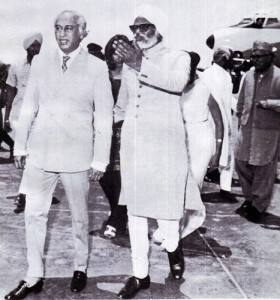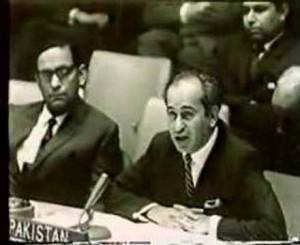Peace Watch » Editor's Take » THU’NAY- YOU NEED TO UNDERSTAND
THU’NAY- YOU NEED TO UNDERSTAND
I believed it. I think so did you? There was no reason not believing it. It was the buzz word: Behind the scene some resolution of Kashmir dispute had been reached’.
Syed Ali Geelani with all eloquence at his command opposed it. He called it betraying the cherished ideal of right to self-determination. He saw it as betraying the commitments of Jawaharlal Nehru, the first Prime Minister of the largest republic in the world. He saw it as defeating the very idea behind the birth of Pakistan. He saw it as great betrayal with the founding father of Pakistan Muhammad Ali Jinnah. He denounced it total erosion of Pakistan’s traditional stand on Kashmir. He publicly called it as defrauding resolutions passed by the comity of nations on New Delhi’s complaint of 30 January 1948. And made us believe we were once again being cheated.
There was no reason for disbelief. The great ‘sons’ party’- the APHC executive was all jubilant about it. The “sons” seemed all ready to push all those Shabirs’, Shahid’s, Nayeems’. Musadiqs’ and Totas’ as hewers of wood and drawers of water down the stream of the forgotten and take a new role unto them. It said enough is enough. There is no better way out than this- it tried to make all of us believe that a resolution of the Kashmir dispute based on the Pakistan President General Pervez Musharraf’s four point formula had been arrived and whatever the solution we need to accept it blindfolded, “ after all beggars cannot be choosers” .
It was not for sons getting ready to don new robes or jokers – (not Shakespearean men with coxcomb) saying it that we made an ass of ourselves by talking about it, holding seminars on it, debating over it or writing about it. I and those in my fraternity might have blackened reams of paper- talking about the ‘four point formula’, debating the possible solution coming out of black tunnel called the backchannel diplomacy, track two, track three, conversational partners and international interlocutors. It was not our tomfoolery- we got dragged into the debate for more serious talking about it.
It were the statements made at the top that something was about to happen that many of us believed that some solution outside the UN resolution had been arrived at by India and Pakistan behind the back of people of Jammu and Kashmir. The then Pakistan Foreign Minister, who apparently seemed no nonsense man had publicly stated that an agreement on Kashmir had been reached and it had been drafted and had just to be signed by Prime Minister, Manmohan Singh and President Musharraf. The coalition of civil society had called a seminar on it in Srinagar. Ostensibly, it was no kite flying the National Security Advisor (NSA) of India M K Narayanan on a private television channel about India doing business with Pakistan President General Pervez Musharraf had substantiated the statement. There was no reason not to believe India’s no-smile-man known for his hawkish ideas on Kashmir. ’’ To quote him: ‘‘I think there are things in the pipeline, things which are cooking, which are half cooked or three quarters cooked, which we would like to take forward,’’ In the beginning of the year 2007, there were reports that a five point agreement had been reached reached between Prime Minister Manmohan Singh’s representative S.K. Lambah and President Musharraf’s Special Advisor Tariq Aziz. There were no specific leaks about the agreement. In 3 December 2007 Outlook a prominent Indian political analyst and an interlocutor between New Delhi and APHC (M) Mr. Prem Shankar Jha had written that the agreement would apply to “whole of original state of Jammu and Kashmir, the borders would be softened. It contained a framework for joint management of common issues like water, power, communications and defense. On democratization and devolution of power to sub-regions, Pakistan would match in its part of Kashmir in its part of Kashmir- the arrangements arrived at between New Delhi and leaders of Indian part of Kashmir”. He reiterated what had written sometime later during his visit to Greater Kashmir office. He blamed some hawks in New Delhi for ‘missing peace opportunity’ or ‘resolution of Kashmir dispute’. Th Pulitzer Prize winning journalist Steve Coll in the New Yorker in March 2009 almost corroborated the assertions made top India and Pakistan leaders. Making a mention about an agreement in his book the Limits of Influence, Howard B Schaffer writes: “These unpublicized but acknowledged back channel talks between designated representatives began in 2004. According to two well informed observers, one Pakistani, the other Indian, five elements of a likely solution emerged from these talks: no territorial change, open borders between two sides of Kashmir; autonomy for them both; reduction of armed forces; and joint institutions of mechanism that would operate throughout the State and would deal with non-controversial issues” (page191).
The debate had made me connect the track two dialogues to backroom decisions taken on 21 October 1947 at 17 York Road, New Delhi and in the anteroom of Prime Minister between Sheikh Abdullah and Pandit Jawharlal Nehru Nehru at the back of people of the state. I had seen the York Road stay and comfort of Sheikh as the first act of the “tragedy’ and the expected back channel accord I had looked as an interlude before the drawing of curtains.
On 7th Feb 2009, I am told the ‘sons’ jubilation’, Geelani anger’; think tanks in Washington and London debating; Fai’s, Shawals’ and Tramboos’ holding international conferences on dynamics of the track-two-agreed-conclusion and my being both for and against it was all uncalled for. Pakistan Foreign Minister, Mehmood Qureshi made us all believe that for four years we were made to suffer a crude joke. There was no agreement on Kashmir that awaited signatures. He rejected the assertions made by former Pakistan Foreign Minister Mehmood Kasuri that Kashmir dispute had reached a point close to settlement as a result of backchannel diplomacy with India.
To quote him:
“Neither I, nor the people of Pakistan have any knowledge about a Kashmir solution evolved by the previous government. No such proposal had never been debated, nor there was any record about it at the Foreign Office. Some proposal might have been a secret between some individuals, but there was no record of it in the Foreign office.”
The achievements of four year backchannel diplomacy can be summed up beautifully in a Kashmir word “thoenay” that I and my friends often used while coin-gambling or playing cricket. It is not for the first that that after waiting for years for the results of much trumpeted back channel diplomacy we suffered thu’nay . In late fifties and sixties Bhutto and Swaran Singh had marathon sessions, resulting in adding another phrase to political lexicon of this land comparing the Kashmir issue to “beautiful damsel’s thigh”.
At the cost of repetition let me quote it again. ““Prem Bhatia while writing about the Swaran Singh-Zulfikar Ali Bhutto meetings in Calcutta in 1963 States that Bhutto was not satisfied with the dialogue process. And he conveyed Bhutto’s discontent with dialogue to Swaran Singh. Indian Minister at this told hin that we have succeeded in putting Bhutto in bhambal bhoosa (Punjabi phrase ‘confusion’. Seeking explanation for Punjabi Phrase
Prem Bhatia had asked Swaran Singh what was India’s policy on Kashmir. India’s Foreign Minister laughed and told him the following story:
“There was once a young handsome girl in his village whose name was Harnam Kaur. She had a number of youthful admirers among the men folk of the village who wanted to make love to her. She kept all of them guessing about her intentions by occasionally baring a part of her thighs (pat in rural Punjabi) as a teaser and half promise of fulfillment. Our Kashmir policy, added Swaran Singh, is like Harnam Kaur’s exposure of her thigh.”
This thoney of 1963 brought us to 1964; Prime Minister Nehru had deputed Sheikh Abdullah to Pakistan not only with much trumpeted proposal of federation but also dropping hint of partition of the state along river Chenab- Stanly Wolpert in his book Zulfi of Pakistan has mentioned the place along which the partition was proposed. 27 May 1964 Nehru died and New Prime Minister, Lal Bhaduar Shastari was ready with another Thoenay- and Sheikh landed in jail. The Tashqand, the Shmila, the Lahore, the Agra and the Post Kargil ended with Thoenays.
In fact it is the phenomenon of Thoenay and defeating it that should engage attention of Kashmir politician including Syed Ali Geelani
*thu’nay is one word substitution in Kashmiri for phenomenon of refusing and admitting the real happening.
Written on FEB 15 2010)
Filed under: Editor's Take · Tags: Geelani, Kashmir Dispute, Mirwaiz, Pakistan, Swaran Singh-Bhutoo, Z. G. muhammad, Z.G. Muhmmad, Zahid G Muhammad, Zahid G Muhmmad, Zulfikar Ali Bhuttoo










In the end the men who matter in India have to realise that they have solve this dispute bcz they can't keep unwilling people with endlessly.